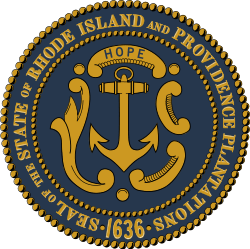Providence Plantations
Providence Plantations was the first permanent European American settlement in Rhode Island. It was established by a group of colonists led by Roger Williams and Dr. John Clarke who left Massachusetts Bay Colony in order to establish a colony with greater religious freedom. Providence Plantations became the Colony of Rhode Island and Providence Plantations, which became the State of Rhode Island and Providence Plantations after the American Revolution.
Providence Plantations | |
|---|---|
Settlement | |
 Providence Plantations Location within Rhode Island  Providence Plantations Location within the United States | |
| Coordinates: 41°49′25″N 71°25′20″W | |
| Country | |
| Settled | 1636 |
| Became colony | November 24, 1663 |
| Founded by | Roger Williams |
| Part of a series on |
| Baptists |
|---|
 |
|
Background |
|
Organizations
|
History
The colony was established at Providence in 1636 by Roger Williams, Dr. John Clarke and a small band of followers who had left the Massachusetts Bay Colony to seek freedom of worship,[1] and two paramount chiefs (sachems) of the Narragansett people, named Canonicus and Miantonomi, granted them a sizable tract of land. The settlers adopted a covenant which stressed the separation of religious and civil affairs.[2] Williams purchased Pawtuxet on the north side of the Pawtuxet River from the Narragansett sachems in 1638. He sold the land that same year to William Arnold and William Harris for the price of a cow.
Samuel Gorton had settled in Newport and in Portsmouth, but he had left each of them due to disagreements with his fellow settlers. He finally left the Providence settlement in January 1643 and founded a new settlement named Shawomet.[3] Meanwhile, the settlers at Pawtuxet were also not getting along well with the other settlements. Arnold even attempted to take control of Providence by altering Williams' original land deed.[4] Arnold ultimately asked Massachusetts Bay Colony to govern Pawtuxet and the surrounding communities.[4]
Massachusetts Bay attempted to extend its authority over Providence Plantations and the settlements in Newport, Portsmouth, and Shawomet during the 1630s and 1640s.[1] (Portsmouth and Newport were on Aquidneck Island, which was called Rhode Island at the time.)[3] Williams traveled to London in 1643 to settle the matter,[1] and he received a parliamentary Commission for Plantations patent the next year uniting Providence with Portsmouth and Newport as "The Incorporation of Providence Plantations in the Narraganset Bay in New England".[2][3] In May 1647, the three towns plus Shawomet (now named Warwick) formed a government under this charter in Providence.[2][3]
Dr. John Clarke sailed back to England November 1651 along with Roger Williams. Williams sailed back to America the following year while Dr. Clarke stayed in London as the Agent for Rhode Island. After 11 years and many drafts, Dr. Clarke wrote and secured the Rhode Island Royal Charter of 1663 from King Charles II on July 8, 1663 which provided a "Full Concernment" in Religious Liberties and Civil Freedoms for the Colony of Rhode Island.
References
- Bicknell, Thomas Williams (1920). The History of the State of Rhode Island and Providence Plantations. 3. New York: The American Historical Society. pp. 975–989.CS1 maint: ref=harv (link)
- Mattern, Joanne (2003). Rhode Island: The Ocean State. Gareth Stevens. pp. 8–11. ISBN 9780836851595. Retrieved May 3, 2018.
- Chisholm, Hugh, ed. (1911). . Encyclopædia Britannica. 22 (11th ed.). Cambridge University Press. p. 512.
- Chisholm, Hugh, ed. (1911). . Encyclopædia Britannica. 22 (11th ed.). Cambridge University Press. p. 252.
- Moyer, Sandra M.; Worthington, Thomas A. (2014). Cranston revisited. Charleston, S.C.: Arcadia Pub. p. 7. ISBN 9781467120791. Retrieved May 5, 2018.
